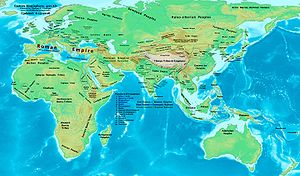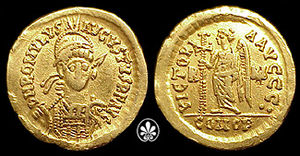
5th century
Background to the schools Wikipedia
This wikipedia selection has been chosen by volunteers helping SOS Children from Wikipedia for this Wikipedia Selection for schools. Do you want to know about sponsoring? See www.sponsorachild.org.uk
| Millennium: | 1st millennium |
|---|---|
| Centuries: |
|
| Decades: | 400s 410s 420s 430s 440s 450s 460s 470s 480s 490s |
| Categories: | Births – Deaths Establishments – Disestablishments |
The 5th century is the period from 401 to 500 in accordance with the Julian calendar in Anno Domini/ Common Era.
Overview
This century is noted for being a time of repeated disaster and instability both internally and externally for the Western Roman Empire, which finally unravelled, and came to an end in AD 476. The west was ruled by a succession of weak emperors, and true power began to fall increasingly into the hands of powerful generals. Internal instability and pressing military problems caused by foreign invaders finally resulted in the sacking of Rome by a Visigoth army in 410. Some recovery was made in the following decades, but the Western Empire received a serious blow when another barbarian group, the Vandals, occupied Carthage, capital of the extremely important province of Africa, a major supplier of wealth and grain. Attempts to retake the province were interrupted by the invasions of the Huns under Attila. After Attila's final defeat and death, both Eastern and Western empires joined forces for a final assault on Vandal North Africa, but their campaign was a spectacular failure.
Events
- 399 – 412: The Chinese Buddhist monk Faxian sails through the Indian Ocean and travels throughout Sri Lanka and India to gather Buddhist scriptures.
- 401: Buddhist monk and translator of sutras, Kumarajiva into Chinese arrives in Chang'an
- Early 5th century – Baptistry of Neon, Ravenna, Italy, is built.
- 405 or 406 _ Mesrop Mashtots Finds the 36 of 38 of the letters of the newly created Armenian Alphabet
- 406: The eastern frontier of the Western Roman Empire collapses as waves of Suevi, Alans, and Vandals cross the frozen Rhine near Mainz, and enter Gaul.
- 407: Constantine III leads many of the Roman military units from Britain to Gaul, occupying Arles (Arelate). This is generally seen as Rome's withdrawal from Britain.
- 410: Rome sacked by Visigoths led by their king Alaric.
- 411: Suebi establish the first independent Christian kingdom of Western Europe in Gallaecia.
- 413: St. Augustine, bishop of Hippo begins to write The City of God.
- 430: Ilopango erupted, devastating Mayan cities in present-day El Salvador.
- 431: First Council of Ephesus, the third ecumenical council which upholds the title Theotokos for Mary, the mother of Jesus Christ.
- 439: Vandals conquer Carthage.
- At some point after 440, the Anglo-Saxons settle in Britain. The traditional story is that they were invited there by Vortigern.
- 451: Council of Chalcedon, the fourth ecumenical council which taught Jesus Christ as one divine person in two natures.
- 451: Persians declare war on Armenians
- 451: Huns under Attila facing the Romans and the Visigoths are defeated in the Battle of Chalons.
- 452: Metropolis of Aquileia is destroyed by Attila the Hun.
- 452: Pope Leo I meets personally with Attila on the Micino River and convinces him not to sack Rome.
- 453: Death of Attila. The Hunnic Empire is divided between his sons.
- 454: Battle of Nedao. Germanic tribes destroy the main Hunnic army and throw off Hunnic domination.
- 455: Vandals sack Rome.
- 455: City of Chichen Itza is founded in Mexico.
- 469: Death of Dengizich, last Khan of the Hunnic Empire.
- 470: Riothamus, King of the Britons, helped the Roman Empire in Brittany against Visigoths.
- 476: August 28: Deposition of Romulus Augustulus by Odoacer: traditional date for the Fall of Rome in the West.
- 477 (or 497): Chan Buddhists found the Shaolin Monastery on Mount Song in Henan, China.
- 480: Assassination of Julius Nepos, the last de jure Emperor of the Western Roman Empire, in Dalmatia.
- 481: Clovis I becomes king of the Western Franks upon the death of Childeric I.
- 486: Clovis defeats Syagrius and conquers the last free remnant of the Western Roman Empire.
- 490: Battle of Mount Badon (approximate date). According to legend, British forces led by Arthur defeated the invading Saxons.
- 491: King Clovis I defeats and subjugates the Kingdom of Thuringia in Germany.
- 493: Theodoric the Ostrogoth ousts Odoacer to become king of Italy.
- 494: Northern Gaul is united under Frankish King Clovis I, founder of the Merovingian dynasty.
- 496: Battle of Tolbiac. King Clovis subjugates the Alamanni, and is baptized as a Catholic with a large number of Franks by Remigius, bishop of Reims.
- Buddhism reaches Burma and Indonesia.
- African and Indonesian settlers reach Madagascar.
- Hopewell tradition ends in North America.
Significant people
- Aetius, last of the great Roman generals
- Alaric I, king of the Visigoths that sacked Rome
- Aspar, Eastern Roman general and politician
- Attila the Hun, king of the Huns
- Augustine of Hippo, bishop, theologian
- Bahram V, Sassanid Shah of Persia
- Bodhidharma, founder of Chan Buddhism
- Boniface, Roman comes in charge of the province of Africa
- John Chrysostom, Patriarch of Constantinople
- Clovis, first Frankish king to unite the Franks; first barbarian king to convert to Catholicism
- Cyril of Alexandria, Patriarch of Alexandria, theologian
- Dioscorus, patriarch of Alexandria
- Faxian, Chinese Buddhist monk
- Geiseric, Vandal king and founder of the Vandal kingdom in North Africa
- Gelasius, bishop of Rome
- Huiyuan, Chinese Buddhist
- Hypatia of Alexandria, woman philosopher
- Jerome, Christian hermit, priest, Latin translator of Bible and other theological works
- John Cassian, Christian monk and theologian
- Kumarajiva, (344-413), Kuchean Buddhist monk and Chinese translator
- Leo I, bishop of Rome, theologian
- Saint Mesrob, Armenian monk
- Nestorius, archbishop of Constantinople, father of Nestorian heresy
- Niall Noigiallach, founder of one of Ireland's greatest dynasties
- Patrick, (Patricius) Catholic bishop, missionary to Ireland
- Pelagius, Catholic priest father of Pelagianism
- Ricimer, Western Roman general, politician and ruler
- Riothamus, King of the Britons, a candidate for the legendary King Arthur
- Tyrannius Rufinus, priest of Aquileia, hermit, Latin translator
- Socrates Scholasticus, Byzantine Church historian
- Sozomen, Christian church historian
- Theoderic the Great, Ostrogothic king
- Yazdegerd I, Sassanid Shah of Persia
- Zu Chongzhi, Chinese astronomer and mathematician
Inventions, discoveries, introductions
- Horse collar invented in China
- Heavy plow in use in Slavic lands
- Metal horseshoes become common in Gaul
- Anglo-Saxon futhorc alphabet used in England
- Armenian alphabet created by Mesrob Mashtots c. 405
Decades and years
|
|||||||||||||||||||||||||||||||||||||||||||||||||||||||||||||||||||||||||||||||||||||||||||||||||||||||||||||||||||||||||||||||||||||||||
|
|||||||||||||||||||||||||||||||||||||||||||||||||||||||||||||||||||||||||||||||||||||||||||||||||||||||||||||||||||




